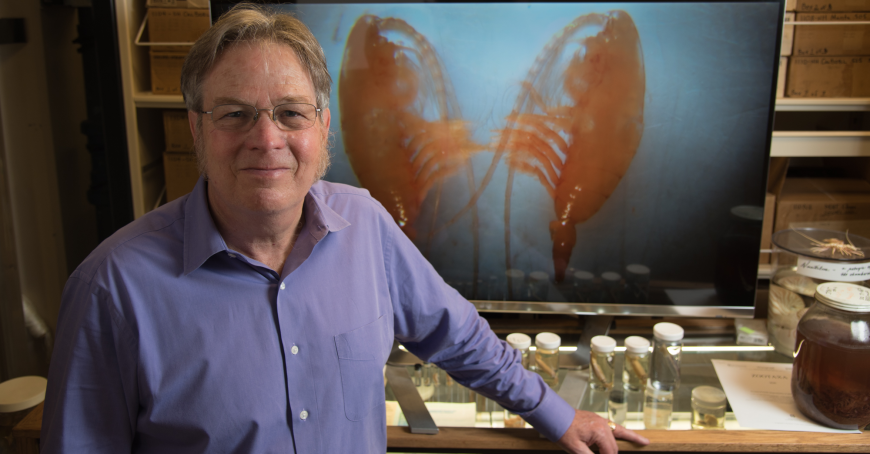Global S&T Development Trend Analysis Platform of Resources and Environment
| Around the Pier: What’s in a Name? | |
| admin | |
| 2017-03-27 | |
| 发布年 | 2017 |
| 语种 | 英语 |
| 国家 | 美国 |
| 领域 | 资源环境 |
| 正文(英文) |  Scripps biological oceanographer and copepod expert Mark Ohman with image of namesake crustacean Luke Skywalker has a gibbon, Beyoncé has a fly, and now Mark Ohman has a second deep-sea copepod named for him. There’s not a more fitting tribute than Megacalanus ohmani for the Scripps Institution of Oceanography at the University of California San Diego biological oceanographer whose career has been devoted to studying theses planktonic drifters, the most abundant animals in the ocean’s water column. “I’m deeply honored,” said Ohman, a professor who is also curator of the Scripps Pelagic Invertebrate Collection. “It’s humbling for an international colleague to recognize my contributions in this manner.” While researching the deep-sea copepod family Megacalanidae, the study’s lead author, Janet Bradford-Grieve of the National Institute of Water and Atmospheric Research in New Zealand, found a treasure trove of information from the Scripps collection and elsewhere that led to the discovery of 11 new species and a complete reclassification of the deep-sea copepod family. “I wanted to acknowledge Professor Ohman’s encouragement and assistance in gaining access to the Scripps collection and more generally his contribution to biological oceanography,” said Bradford-Grieve, who described M. ohmani and the other new species in a recent published paper in the journal Zootaxa. M. ohmani’s discovery originated from a preserved sample held at Scripps that dates back to a 1976 research voyage on the former Scripps research vessel Thomas Washington. The copepod was collected on Sept. 19, 1976, just west of the Indonesian province of West Papua using an Isaacs-Kidd midwater trawl invented by legendary Scripps Professor John Isaacs. The analysis by Bradford-Grieve confirmed that it was anatomically distinct from the Atlantic, western Pacific, and eastern Pacific species, which led to the new species designation. The reddish copepods that make up the Megacalanidae family are among the largest deep-sea planktonic copepods in the ocean, reaching up to 17 millimeters in length. As prey for lanternfish and other deep-sea fish, they play a fundamental role in the marine ecosystem and are studied for their close connection to ocean biogeochemical cycles and the health and productivity of the world’s oceans. Detailed taxonomic descriptions of organisms like these are essential for Ohman’s research on the effects of climate variability on the California Current Ecosystem as lead investigator of the National Science Foundation-supported California Current Ecosystem Long-Term Ecological Research (CCE-LTER) program. In 2012, the Atlantic deep-sea copepod Xancithrix ohmani was named after Ohman, who has been curator of the Scripps collection for 26 years and uses the collection holdings extensively for his own research. In the tradition of honoring scientists for their research contributions, three of the new species described by Bradford-Grieve have a unique academic lineage linked to Scripps. The western Pacific species was named Megacalanus ericae for zooplankton ecologist Erica Goetze, a former Scripps PhD student advised by Ohman. And Ohman’s own PhD advisor, Bruce Frost, a Scripps alumnus and a leader in the study of planktonic copepods, was honored with the eastern Pacific species Megacalanus frosti. Scripps has pelagic invertebrate specimens in the collection dating back to the institution’s founding in 1903. Today, scientists from all over the world visit the zooplankton collection and specimens are loaned out to scientists for studies ranging from climate change, evolutionary mechanisms, and larval fish survival to plastic pollution. “Nobody collected those samples with the thought of measuring plastic pollution,” said Ohman. “This is the importance of collections: you don’t know how useful they will become as time goes on. There are always unanticipated new directions to pursue with these superb archives.” “I cannot emphasize enough how important the Scripps collections are, not only in the present, but will increasingly be in the future,” Bradford-Grieve added. According to Ohman, there are untold new species in the collection waiting to be discovered. In the tradition of honoring scientists for their lifelong research contributions, in 1958 Scripps biological oceanographer Martin Johnson named the copepod Elenacalanus sverdrupi for the former Scripps director Harold Sverdrup. – Annie Reisewitz This story appears in explorations now, Scripps Institution of Oceanography's award-winning ocean and earth science magazine. Sign up to receive our free monthly story roundup.
|
| URL | 查看原文 |
| 来源平台 | Scripps Institution of Oceanography |
| 文献类型 | 新闻 |
| 条目标识符 | http://119.78.100.173/C666/handle/2XK7JSWQ/107617 |
| 专题 | 资源环境科学 |
| 推荐引用方式 GB/T 7714 | admin. Around the Pier: What’s in a Name?. 2017. |
| 条目包含的文件 | 条目无相关文件。 | |||||
| 个性服务 |
| 推荐该条目 |
| 保存到收藏夹 |
| 查看访问统计 |
| 导出为Endnote文件 |
| 谷歌学术 |
| 谷歌学术中相似的文章 |
| [admin]的文章 |
| 百度学术 |
| 百度学术中相似的文章 |
| [admin]的文章 |
| 必应学术 |
| 必应学术中相似的文章 |
| [admin]的文章 |
| 相关权益政策 |
| 暂无数据 |
| 收藏/分享 |
除非特别说明,本系统中所有内容都受版权保护,并保留所有权利。
修改评论